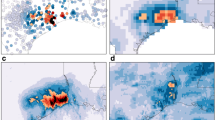Summary
The technique of principal component analysis and of cluster analysis has been applied to two sets of precipitation data in Switzerland, one containing 47 stations (1961–80), and the other 101 stations (1981–1993), with the aim of understanding more fully the spatial distribution of precipitation regimes. Seven regions were highlighted in the first case and 13 in the second. The high spatial coherence which appeared is quite remarkable and confirms the usefulness of these techniques for the analysis of the spatial distribution of meteorological variables, even in a topographically complex area such as Switzerland. The two regional distributions obtained not only correspond fairly well to the large, well-known physical regions of Switzerland, but also go much further, separating the Swiss Plateau into 3 clearly differentiated regions, for example. Regional distributions such as those discussed here can have value for climate change issues, and in particular numerical modeling of climate or climate change impacts on forests.
Similar content being viewed by others
References
Auer, I., Böhm, R., 1994: Combined temperature-precipitation variations in Austria during the instrumental period,Theor. Appl. Climatol. 49, 161–174.
Bantle, H., 1989:Programmdokumentation Klima-Datenbank am RZ-ETH Zürich. Zürich: Swiss Meteorological Institute.
Baeriswyl, P.-A., 1996: Differences régionales des précipitations et de l'insolation relative en Suisse.Publications de l'Association Internationale de Climatologie (in press).
Beniston, M., Rebetez, M., Giorgi, F., Marinucci, R., 1994: An analysis of regional climate change in Switzerland,Theor. Appl. Climatol. 49, 135–159.
Beniston, M., 1996: Variations of snow depth and duration in the Swiss Alps over the last 50 years: links to changes in large-scale climatic forcings.Climatic Change, (in press).
Beniston, M., Rebetez, M., 1996a: Regional behavior of minimum temperatures in Switzerland for the period 1979–1993.Theor. Appl. Climatol. 53, 231–243.
Breiling, M., Charamza, P., 1994: Sensitivity of mountain runoff and hydro-electricity to changing climate. In: Beniston, M. (ed.)Mountain Environments in Changing Climates. London, New York: Routledge Publishing Company, pp. 91–107.
Briffa, K. R., Jones, P. D., Hulme, M., 1994: Summer moisture variability across Europe, 1892–1991: an analysis based on the Palmer drought severity index.Int. J. Climatol. 14, 475–506.
Catell, R. B., 1966: The scree test for the number of factors.Multivar. Behav. Res. 1, 245–276.
Ehrendorfer, M., 1987: A regionalization of Austria's precipitation climate using principal component analysis.J. Climatol. 7, 71–89.
Fernandez Mills, G., 1995: Principal component analysis of precipitation and rainfall regionalization in Spain.Theor. Appl. Climatol. 50, 169–183.
Gajic-Capka, M., 1993: Fluctuations and trends of annual precipitation in different climatic regions of Croatia.Theor. Appl. Climatol. 47, 215–221.
Gregory, J. M., Jones, P. D., Wigley, T. M. L., 1991: Precipitation in Britain: an analysis of area-average data updated to 1989.Int. J. Climatol. 11, 331–345.
Groisman, P. Y., Legates, D. R., 1995: Documenting and detecting long-term precipitation trends: where we are and what should be done.Climatic Change 31(2–4), 601–622.
IPCC, 1996: Climate Change. In: Houghton et al. (eds.)The IPCC Second Assessment Report. Cambridge: Cambridge University Press.
Kaiser, H. F., 1958: The varimax criterion for analytic rotation in factor analysis.Pyrometrical 23, 187–200.
Jackson, J. E., 1991:A User's Guide to Principal components. New York: Wiley, 569 pp.
Jolliffe, I. T., 1987: Rotation of principal components: some comments.J. Climatol. 7, 507–510.
Jolliffe, I. T., 1990: Principal component analysis: a beginner's guide — I. Introduction and application.Weather 45, 375–382.
Jolliffe, I. T., 1993: Principal component analysis: a beginner's guide — II. Pitfalls, myths and extensions.Weather 48, 246–253.
Molteni, F., Bonelli, P., Bacci, P., 1983: Precipitation over Northern Italy: a description by means of principal component analysis.J. Climate. Appl. Meteor. 22, 1738–1752.
Ogallo, L. J., 1989: The spatial and temporal patterns of the East african seasonal rainfall derived from principal component analysis.Int. J. Climatol. 9, 145–167.
Preisendorfer, R. W., Mobley, C. D., 1988:Principal Component Analysis in Meteorology and Oceanography. Amsterdam: Elsevier, 425 pp.
Rebetez, M., 1996: Seasonal relationships between temperature, precipitation and snow cover in Switzerland.Theor. Appl. Climatol. 54, 99–106.
Rebetez, M., Lugon, R., Baeriswyl, P. A., 1996: Climatic warming and debris flows in high mountain regions: The case study of Ritigrabe, Switzerland.Climatic Change, (in press).
Regenmortel, van G., 1995: Regionalization of Botswana rainfall during the 1980s using principal component analysis.Int. J. Climatol. 15, 313–323.
Richman, M. B., 1986: Rotation of principal components (review article).J. Climatol. 6, 293–335.
Schoenwiese, C.-D., Staehler, U., Birrong, W., 1990: Temperature and precipitation trends in Europe and their possible link with greenhouse-induced climatic change.Theor. Appl. Climatol. 41, 173–175.
Ward, J. H., 1963: Hierarchical grouping to optimize and objective function.J. Amer. Statistical Association 58, 236.
White, D., Richman, M., Yarnal, B., 1991: Climate regionalization and rotation of principal components.Int. J. of Climatol. 11(1), 1–25.
Willmott, C. J., 1978: P-mode principal components analysis, grouping and precipitation regions in California.Arch. Met. Geoph. Biokl. Serie B 26, 277–295.
Zhao, W., 1991: The relationship between precipitation and temperature over the continental United States. M.S. thesis, Global Change Research Center, Department of Environmental Science and Engineering, Oregon Graduate Institute of Science and Technology.
Zhao, W., Khalil, M. A. K., 1993: The relationship between precipitation and temperature over the contiguous United States.J. Climate 6, 1232–1236.
Author information
Authors and Affiliations
Additional information
With 7 Figures
Rights and permissions
About this article
Cite this article
Baeriswyl, P.A., Rebetez, M. Regionalization of precipitation in Switzerland by means of principal component analysis. Theor Appl Climatol 58, 31–41 (1997). https://doi.org/10.1007/BF00867430
Received:
Issue Date:
DOI: https://doi.org/10.1007/BF00867430




